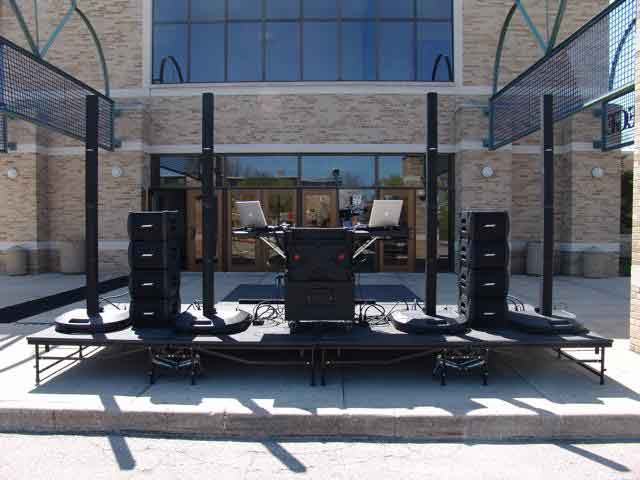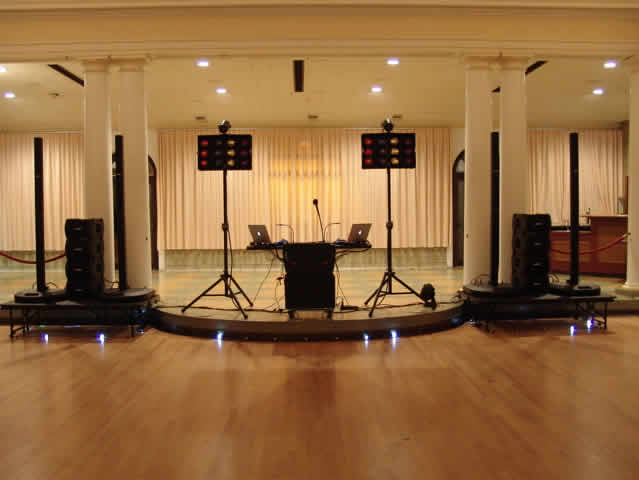Live or PreRecorded / Stereo and *-Mono
Chris-at-Bose [1]
Listening test report
On Wednesday June 7, 2006 a group of us-at-Bose set up in our performance lab a stereo system of 4 L1s and 8 B1s in the same arrangement shown in the photo by Mike Early
and another shot indoors
We listened to four variants of this system without moving any speakers, just by turning things off or re-wiring inputs to the PS1s.
- 1) Mike’s full setup with all 4 L1s and all 8 B1s, called here “4+8”. Left channel is fed to the two left PS1s, right channel to the two right PS1s. All gains equal and preset 00. (It is important to match levels on all 4 L1s. We did this by listening to two at a time, standing equidistant from the pair and tweaking levels in mono until the image was centered. First we did this with the left two, then the inner left and right ones, then the right two. Once they were all matched this way, we turned them all on for the tests.)
- 2) Turning off the outer two L1s and their double bass packages gave a standard DJ stereo setup of two double-bass line arrays, called here “2+4”.
- 3) A quad bass DJ stereo setup with the same inner two line arrays, using the outer two PS1s to drive only the extra pairs of B1s, called here “2+8”. You would get the same result if you drove the extra B1s with Packlites instead.
- 4) One double-bass package alone, called here “1+2”.
With these four arrangements, we did two separate listening experiments, one for stereo pre-recorded material and one for live vocals from a microphone. We were mostly listening for any vocal interference problems that might come from distributing signals to multiple speakers. Here is what we heard.
1.) Compared pre-recorded stereo material on 2+4 vs. 2+8 vs. 4+8
Very good sound quality, as expected. Also very good if we try preset 57 here, as many DJs do. Now that we’re concentrating on vocal interference, we notice that all the vocals are compromised a little by this effect as soon as we move off the centerline. It’s less significant once we get out to the side. This seems to be a normal problem with all stereo loudspeakers that we’ve taken for granted all along. It’s one reason stereo doesn’t sound as good when you’re not in the middle.
Essentially the same results as 2+4, but of course it can reach louder levels than the 2+4 on bass-heavy material.
Mike is right to praise this system. It sounds tonally very good and is capable of producing a truly ferocious amount of clean sound. We do hear some interference in the vocals across the whole front, and it’s spread a little wider than with the 2+4. The level difference between out front and to the side was a little more than the 2+4. None of these differences prevented us from really enjoying the over all sound.
2.) Compared live microphone vocals on 4+8 vs. 2+4 vs. 1+2
Sounds like PA
sounds like PA
sounds like it’s alive! A living person with a mighty voice. This reminds us of why we have always encouraged live performers to each have their own single line array.
Conclusions
In my previous post, I was excited by the anticipation of learning something new, and now we have. Here are our conclusions:
- The minor degradation of midrange interference off the centerline probably cannot be avoided when recorded stereo material is played on any speakers. This is one of the compromises of the stereo format itself.
- The interference of 4 L1s playing stereo is not much more significant than two L1s, so it is fine to use four in stereo when needed to produce enough level for recorded music.
- For live sources, the interference of multiple speakers can be completely avoided by not distributing any source to more than one speaker.
- Exception: true "distributed systems". To cover a single very wide or irregular area, it may be necessary to space your L1s, using a 20-50 foot spacing between them (6-15m). In the installed sound world, this is known as a distributed system. In this case, you should send the same signals to all the widely spaced L1s. If the source is stereo, it is common practice to combine L&R for distribution in such a system.
These conclusions clear up the apparent discrepancy between Mike’s good results and our suggestion that sources not be distributed. We stand by our suggestion for live sources, but there is no way to prevent interference with recorded stereo, so four speakers vs. two is not a critical issue in that case. We are happy to have people use this 4+8 arrangement for pre-recorded stereo in cases where you need more sound than 2+4 or 2+8 can provide.
Thanks very much for discovering and promoting this, Mike. It goes beyond what we thought the system could do. This is a beautiful example of the fact that the forum benefits Bose as well as our customers.
Chris





